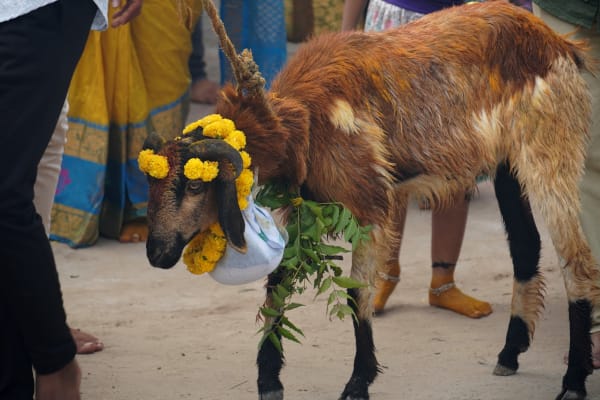Veranda Tales-The golden snake goddess

Storytelling has been an integral part of my life since childhood. I grew up listening to stories during the hot summer evenings and nights with my cousins. Mothers and grandmothers would gather all of us children for story time. It was usually pitch dark except for a very faint light coming from the flickering candle. Power cuts were as frequent as the hot and humid summer days. We all spread out on a cool concrete floor or bamboo mats on the veranda intently listening to fascinating stories about kings, queens, princes, princesses, and peasants alike. Stories about love, life, families, and people entertained and taught us life skills. These stories transported us to distant worlds, strange yet familiar. Often the same story told by two people sounded different as storytellers added new twists and turns adding their personal style and flair to the stories.
Storytelling wasn’t limited to summer evenings and bedtime. I was surrounded by adults who didn’t pass up an opportunity to share their wisdom using the art of storytelling. These rich vibrant oral traditions include songs, poems, stories, and సామెతలు (Sametalu are proverbs in Telugu). Men and women sing songs as they work in the fields, grinding grains and spices and doing other daily chores at their homes. Stories are often used to teach important life lessons, interpersonal skills, and survival skills. These stories and the time spent listening to them made our lives richer leaving an impression on me. This series is all about reliving those memories as I share these stories.
శ్రీకనక నాగారపమ్మ (Sri Kanaka Nagarpamma)
Present becomes past, past becomes memory, and memory becomes a legend. As annals of history are buried under dust, some legends are forgotten and lost. A few legends that stand the test of time are kept alive for generations as each generation passes it down to the next.
Once upon a time there lived a man in a small village near current day Vetapalem in the state of Andhra Pradesh in India. He lived a long time ago before the British occupation and before the state was founded. His name was Nayanari. He had a wife and children. He served as a Tahsildar or an executive magistrate for the region he lived in. As a magistrate he was responsible for collecting taxes from people in the area of his jurisdiction and maintaining records. He went to the court periodically to deliver the revenue from tax collection.
As he was stepping out of the house to head to the court, his wife brought to his attention that they didn’t have any food to eat. When Nayanari went to the court he was away for months at a time. His wife was worried about feeding the children and taking care of them. Nayanari told her to check the sandmound in their backyard and left. His wife went back into the house and into the backyard to find that the sand turned into rice grain. She heaved a sigh of relief knowing that she could trade the rice grain for vegetables and other household items.
Months went by, the family was thriving and it was time for Nayanari to start his journey to get back home to his family. He gathered his things and records. In those days records were kept on తాళపత్ర (taalapatra is Palm leaf used for writing in Telugu). He secured the records in a కవిలాల కట్ట (kavilala katta) using a fine silk fabric to bundle them in. కవిలాల కట్ట (kavilala katta) is fancy word for bundling records or books like a poet would. Books are records are kept in the middle of a square fabric and the opposite two ends of the fabric are tied together in a knot. When the second knot is formed with the remaining two ends, the bundle is secure and can be carried on the head. People carry such bundles in India even today, balancing them on their heads. They have their arms free as they effortlessly balance large bundles on their heads. I doubt I can take even one step before the bundle falls down on the floor.
Nayanari bowed to the King and left the రాజ్యసభ (rajya sabha is King’s court in Telugu) and the bustling and రాజధాని (rajadhani is the capital city in Telugu) behind. Soon after he was walking through small villages and forested areas stopping to take rest along the way. As he was getting closer and closer to his village, the bundle on his head kept getting heavier and heavier. He also heard a voice saying, “I am following you”. It was an authoritative female voice. He first thought he was tired and imagining things. As the voice grew louder and the bundle got heavier and heavier, he got tired. He set the bundle down on the ground. As soon as he set the bundle down, a small golden నాగుపాము (Naagupaamu is Indian Cobra in Telugu) slithered out of the bundle and quickly disappeared into a nearby పాముపుట్ట (paamuputta is a snake pit in Telugu).
Nayanari watched the shiny golden నాగుపాము (Naagupaamu) slithering out of the bundle in awe and disappearing into the పాముపుట్ట (paamuputta). He was concerned about the safety of this tiny creature that traveled with him. He sat there for a few minutes and picked up the bundle and went home. He was happy to see his wife and children. He washed up, ate a hot meal his wife had prepared and went to bed. The golden నాగుపాము (Naagupaamu) appeared in his dream. She asked him to do something for her.
She instructed him to build a temple in a peaceful place away from humans. She didn’t want to be disturbed by the noises of rice pounders and roosters. He woke up in the morning and went about his business thinking nothing of the dream. She kept appearing night after night making the appeal for a temple. He could no longer ignore that the dream was just a dream. He recognized that the నాగుపాము (Naagupaamu) was శ్రీకనక నాగారపమ్మ (Sri Kanaka Nagarpamma). He told his wife and she agreed that he had to build a temple.
He started saving money for the temple and once he had enough money, he built a temple where he last saw the నాగుపాము (Naagupaamu). శ్రీకనక నాగారపమ్మ (Sri Kanaka Nagarpamma) means golden Nagarpamma. He worshiped the goddess until his death and his descendants continue to worship the goddess.
Nayanari’s descendents came to be known as Nayani clan and we continue to worship శ్రీకనక నాగారపమ్మ (Sri Kanaka Nagarpamma) as our ancestors did. My first memories of visiting the temple include getting off the train at Vetapalem train station and walking with my cousins, aunts, uncles, and my parents to the temple crossing sand dunes wearing Hawai chappal, flip flops sold by Bata. Hawai chappal sank into the sand as I walked and I had to pull them up. After struggling for a while, I simply carried the chappal in my hand as my feet dug into the hot sand.
Once we reached the temple we got busy making పొంగలి (pongali) from fresh milk, rice, and jaggery. On some occasions goats or lambs were readied for sacrifice. Readying them for sacrifice involves applying పసుపు (Pasupu is Turmeric in Telugu)and కుంకుమ (kumkum) to their foreheads, tying a garland of lemons or flowers and fresh green Neem leaves around their necks. Once the పొంగలి (pongali) is ready, the hot pot full of boiling పొంగలి (pongali) is carried to the temple along with the goats for the blessing from the goddess and her పూజారి (Pujari is priest in Telugu). Once the meat is prepped, it is turned into delicious khorma for lunch.

I had a dream a few months ago in which a golden snake was wiggling under a light yellow blanket on my bedroom floor. The blanket was rippling up and down as the radiant snake moved up, down, and sideways. It was like watching a shiny light wave shaped like a snake crawl under the blanket back and forth. I happened to visit the temple soon after. The goddess was the same as I remembered from my childhood trips to the temple, with her smile and golden eyes looking at you.
The temple reminded me of my earlier visits when I was a child. As usual the whole area surrounding the temple bustled with families as they gathered to prepare their feast and enjoy it. There was a guy sitting there with a large grinder continuously grinding ginger, garlic, and other spices for people who sought his services to get their spices ground. Kids were running around playing while adults were busy cooking and chatting. While the cooking was underway, we relaxed under the shade of mango groves surrounding the temple grounds. We had our own area to cook and serve lunch. We enjoyed the meal starting with పొంగలి (pongali) followed by delicious pulao rice, khorma, and raita. Meals usually end with fresh yogurt mixed with plain rice.
As I walked the temple grounds I tried to imagine what it would have been like to be there at the beginning. There is no way to know how long ago our ancestor Nayanari built the first temple. The temple was rebuilt and it is known to be 150 years old. Whether the legend of our ancestor's encounter with the goddess is true or not, the legend lives on as we continue to gather at the temple for joyous reunions and as the story is told and retold to pass it down from one generation to the next.
